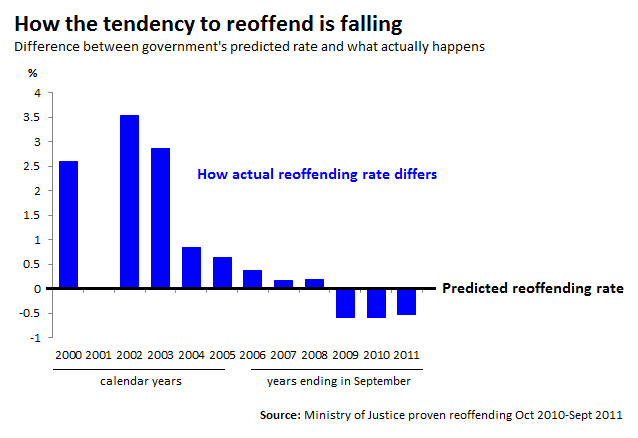Reoffending: 'doggedly high' or actually falling?
Government departments can normally be expected to strike a positive tone when it comes to the state of the nation. So it will have been surprising to some when the Ministry of Justice claimed last month not only that "reoffending is up" but also that "there has been little change in reconviction rates".
Justice Secretary Chris Grayling explained the reasoning: "These figures make a compelling case for our important reforms - reoffending rates remaining doggedly high"
The BBC's Mark Easton didn't seem to agree at the time:

Just looking at raw reoffending rates is deceptive
Proven reoffending, which is what the Minister was commenting on, is defined as any offence committed in a one year follow-up period and receiving a court conviction, caution, reprimand or warning in the one year follow-up. It's not a complete measure of every time an offender has reoffended.
The latest proven reoffending figures, show that the reoffending rate for adults went up from 25.1% to 25.6% since last year, and for juveniles (aged 10-17) from 34.8% to 36.1%.
Since 2000 both rates have changed very little: adult reoffending was 26.2% then and 25.6% now. Juvenile reoffending has increased from 33.7% in 2000 to 36.1% now.

Except that isn't what's really going on at all.
The government expects reoffending to have risen given who's offending in the first place
The problem with simply comparing the proven reoffending rate in 2000 with the one in 2011 is that the people who were being monitored for reoffending in 2011 were a different bunch to the people being monitored in 2000.
For example, say you find that men are more likely to reoffend than women (the government actually has). If all the offenders in 2000 happened to be women and all the offenders in 2011 happened to be men, you'd expect reoffending to be higher - not because of any policy or initiative but because the 2011 bunch were characteristically more prone to reoffend.
That's exactly what the government tries to take into account. It bases its modelling on men being more likely to reoffend than women; on older adults being more likely than young adults and on ethnic minority people being more likely than white people. Offending history plays a part as well.
So the tendency to reoffend depends on how people live up to the government's expectations
Accounting for characteristics means the government can predict how many people 'ought' to reoffend given who they are. If the actual recorded rate of reoffending compared to this trends downwards, we can be pretty sure that the tendency to reoffend is going down, even if the actual rate of reoffending is stable or going slightly up.
So taking this measure on board, the bigger picture shows reoffending rates have fallen by 3.1% for adults and 1% for juveniles since 2000, although the trend has been broadly flat since 2009.

"Pretty sure" flags up an important caveat. The government's model isn't perfect - it doesn't take into account factors like whether offenders take drugs, drink alcohol or even have a job, even though you'd think these might be related to whether someone reoffends.
Still, the trends since 2000 on this basis show that - for the same 'kinds' of people - reoffending has fallen over the past decade.
The Ministry of Justice claim there's a "compelling" case for reform given that proven reoffending rates remain high. It's true that rates haven't changed much for the best part of seven years, but that's not all the figures say.
The government is still right to point out reoffending is up in the most recent year, but given the tendency to reoffend has fallen over the long-term, this suggests that describing this as a "doggedly high" trend doesn't do justice to what's really going on.
UPDATE 17 Aug: This article was updated to make clear that these statistics measure proven reoffending not all reoffending.